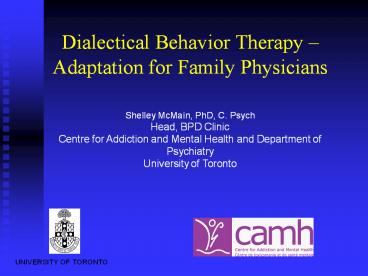Dialectical Behavior Therapy – Adaptation for Family Physicians - PowerPoint PPT Presentation
1 / 22
Title:
Dialectical Behavior Therapy – Adaptation for Family Physicians
Description:
Dialectical Behavior Therapy Adaptation for Family Physicians Shelley McMain, PhD, C. Psych Head, BPD Clinic Centre for Addiction and Mental Health and Department ... – PowerPoint PPT presentation
Number of Views:180
Avg rating:3.0/5.0
Title: Dialectical Behavior Therapy – Adaptation for Family Physicians
1
Dialectical Behavior Therapy Adaptation for
Family Physicians
Shelley McMain, PhD, C. Psych Head, BPD
Clinic Centre for Addiction and Mental Health and
Department of Psychiatry University of Toronto
2
Objectives
- Be familiar with DBTs biosocial theory of BPD
- Identify two core DBT strategies used to
effectively engage individuals with BPD - Be familiar with strategies to reduce burnout and
enhance self care
3
BPD Diagnosis
- Personality Disorder
- enduring pattern of inflexible and maladaptive
traits which causes impairment or distress - arbitrary cutoff between BPD and traits 5/9
- utility of diagnosis
- diagnosis not made by your own reaction to the
patient
4
Dialectical Behavior Therapy
- Standard DBT is a comprehensive, multimodal
treatment originally developed for people with
BPD - DBT has been adapted for various patient
populations and across a variety of settings - Any professional can implement selected
strategies
5
Vignette 1
- 42 year old single woman with chronic suicidal
and self harm behavior - Tx history includes numerous psychotropic
medications, lengthy hospital stays and repeated
ER visits, lengthy history of psychosocial
treatments - Patient frequently presents in a state of
emotional often angrily demanding more time and
additional appointments
6
Clinical Consideration
- How do you understand this patients problems?
- If you believe that this patient meets criteria
for BPD, should you discuss the diagnosis? - How should you engage this patient?
7
Etiology of BPDDBTs Bisosocial Theory
Emotion Modulation Deficits
High Emotion Vulnerability
Problematic Behaviours (e.g. suicide, substance
use)
8
DBTs Biosocial Theory
Fruzzetti et al, 2005
9
Educate Patients about BPD diagnosis
- Helps to de-stigmatize diagnosis
- Helps to increase hopefulness about possibility
for change - Encourages active participation in treatment
planning - Education about the diagnosis has been shown to
reduce symptoms (Zanarini,2008)
10
Adopt a Clear Treatment Structure
- Establish a treatment contract clarify your
roles, responsibilities, treatment goals - Clarify structure of appointments frequency of
appointments, expectations about attendance - Be clear about your limits and availability
- Anticipate and plan for crises
- APA, 2001
11
Guidelines on Concomitant Treatments
- Treatment by more than one clinician is viable
however good collaboration is essential (APA,
2001). - Someone should be identified as the primary
clinician - (APA, 2001 Oldhman et la., 2001 Gabbard, 2000
- Gunderson, 2001 Linehan, 2003 Kernberg, ).
12
Clinical Vignette 2
- Ill kill myself if you dont get me admitted to
the hospital for the weekend - Patients parting words to therapist who
indicated that she didnt think that
hospitalization would be helpful
13
Clinical Considerations
- Is this client being manipulative?
- How should you respond?
- If you attend to the suicide threat will you
reinforce this behavior? - Should she be hospitalized?
14
Functions of Self-injurious Behaviour
Gunderson, 2001 adapted from Shearer, 1994b
15
Opt For the Least Restrictive Safe Treatment
Setting
- Hospitalization may be iatrogenic
- Hospitalization should be viewed as a vehicle for
maintaining safety - Hospitalization should be considered if the risk
of suicide outweighs the risk of inappropriate
hospitalization - Focus on helping patients cope in their natural
environment
16
Validate and Emphasize Patient Control
- Move flexibly from validating kernal of truth and
helping patient take responsibility (APA, 2001) - Dont rush in and take care of patient
- Dont reinforce dysfunctional behavior with extra
attention (i.e., avoid scheduling extra
appointments in response to self-harm) - Validate patients capability of behaving
reasonably
17
Validation
- Why Validate?
- an essential need of people with BPD
- the only way to build alliance
- reduces distress
- reduces polarization
- a prerequisite for cooperation
- How to Validate?
- listen, reflect
- make educated guesses at what shes not saying
(read her thoughts and emotions) - normalise
- remember where shes coming from
- find what is valid, right or understandable
18
Encourage Effective Coping
- Always start by validating AND then
paradoxically - Cheerlead - validate her strength and ability to
cope/survive - 2. Reinforce progress towards goal - reinforce
the small steps - 3. Negotiate - offer the options you are willing
to offer and have clear limits - 4. Suggest alternatives to the behaviour if
possible
19
Vignette 3
- Thinking of your patient or seeing your patient
evokes the following response - hope that shell get admitted to hospital
- relief when she cancels
- daydreaming about transferring her care
- Wish that youd chosen another career
- feeling angry or irritated with her (comments to
office staff)
20
Reducing Burnout
- Validate yourself since stress is understandable
- Validate your patient remind yourself of why
she is doing the best she can - Seek support from colleagues
- Assume responsibility for observing your personal
limits
21
Observing Your Personal Limits
- Monitor your limits with your patients
- Be honest with yourself and clear with your
patients about your limits - Observing limits is different than setting
boundaries - When your client exceeds your limits, validate
and problem-solve - negotiate a better arrangement for yourself (more
resources for the patient?)
22
Summary
- DBTs biosocial theoretical model can increase
understanding of symptoms. - Educate patients about the diagnosis
- Treatment should be well structured
- Emphasis on validation in addition to helping the
client control behavior - Observe your limits and get support

